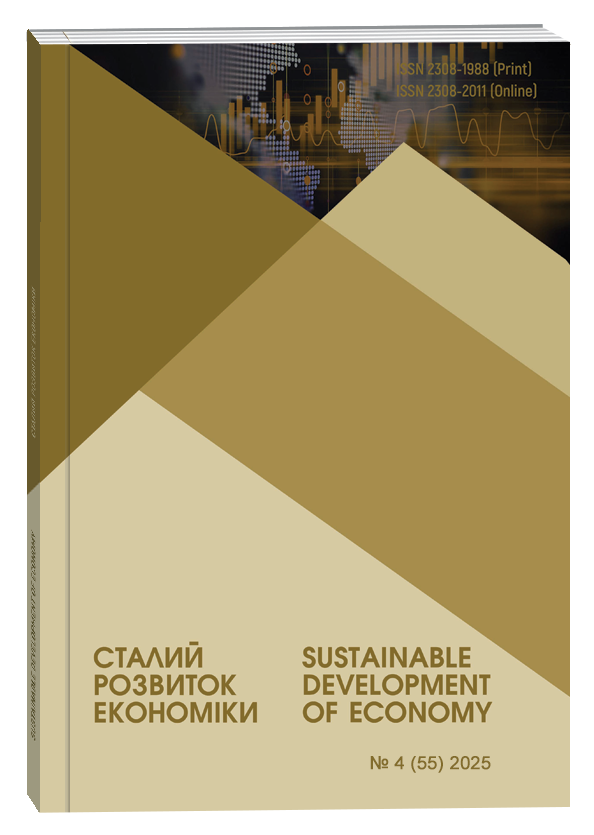BUSINESS AND INDUSTRIAL PARKS AS A FACTOR IN ENHANCING CROSS-BORDER ENTREPRENEURSHIP
Abstract
The article provides an in-depth examination of the role of business and industrial parks in fostering cross-border entrepreneurship within the context of European integration and regional economic transformation. It offers both a theoretical and empirical analysis of the development of cross-border business infrastructure in the European Union, focusing on how such parks stimulate innovation, investment, and employment in peripheral regions. Drawing on comparative data from OECD, Eurostat, and the Ministry of Economy of Ukraine, the paper identifies the institutional, infrastructural, and financial prerequisites necessary for establishing effective transboundary cooperation zones. The research applies a structural-functional and comparative methodology to assess the dynamics of industrial park performance and their contribution to regional competitiveness. Particular attention is paid to the experience of EU member states participating in INTERREG and Cross-Border Cooperation programmes, as well as to the adaptation of these practices to Ukrainian border regions such as Zakarpattia, Volyn, and Lviv. The findings reveal that business and industrial parks act as catalysts for integrating local enterprises into global value chains, encouraging cluster formation, and strengthening innovation ecosystems. The study proposes an integrated model for the development of cross-border business parks that combines coordinated governance, synchronized infrastructure, and shared innovation funds. This model is based on the principles of the Triple Helix interaction between government, business, and academia. The originality of the research lies in the author’s conceptualization of a multi-level mechanism that enables the alignment of national and European policies in promoting regional entrepreneurial ecosystems. The practical significance of the study is determined by its applicability to policymaking, local governance, and public–private partnership projects aimed at post-war economic recovery and regional development. The results can serve as a methodological foundation for designing new industrial and innovation zones along the Ukrainian-EU border, increasing investment attractiveness, and accelerating Ukraine’s integration into the European economic area.
References
Куровська-Пиш Й. Можливості транскордонного підприємництва. Sustainability, 2016, т. 8, № 3, с. 230–238.
Анісєвич Р. Умови розвитку підприємницької екосистеми у сфері туризму в прикордонних регіонах Європейського Союзу. Sustainability, 2021, т. 13(24), с. 13595–13610. DOI: https://doi.org/10.3390/su132413595
Багацька К., Білоус Н. Стимулювання підприємницької активності під час воєнного стану: досвід України. Journal of Public Governance, 2024, т. 69, № 3, с. 53–66. DOI: https://doi.org/10.15678/PG.2024.69.3.01
Сітницький М. В. та ін. Розвиток і підтримка вітчизняного підприємництва в Україні. Sustainability, 2024, т. 16, № 13.
Організація економічного співробітництва та розвитку (ОЕСР). Транскордонні потоки даних. Париж: OECD Publishing, 2023, 8 с.
Міністерство економіки України. Звіт про стан реалізації політики щодо індустріальних парків в Україні. Київ, 2025, 30 с.
Лачни М., Міхалкова Я. Транскордонне співробітництво на словацько-українському прикордонні. Borders in Globalization Review, 2025, с. 10–25.
Європейська Комісія. Щорічний звіт INTERREG Europe 2024. Брюссель: EC, 2024, 15 с.
Закон України «Про індустріальні парки» № 5018-VI від 21 червня 2012 р. (зі змінами від 01.09.2023). Відомості Верховної Ради України, 2023, № 37, ст. 1124.
Кабінет Міністрів України. Стратегія розвитку промисловості України до 2030 року. Київ, 2023, 56 с.
Європейська Комісія. Політика основної мережі TEN-T. Брюссель: Головне управління з питань мобільності та транспорту, 2024, 25 с.
Kurowska-Pysz, J. (2016). Opportunities for Cross-Border Entrepreneurship. Sustainability, no. 8(3), pp. 230–238.
Anisiewicz, R. (2021). Conditions for Development of the Entrepreneurial Ecosystem in Tourism in the Border Area of the European Union. Sustainability, no. 13(24), pp. 13595–13610. DOI: https://doi.org/10.3390/su132413595
Bahatska, K., & Bilous, N. (2024). The Stimulation of Entrepreneurial Activity During Wartime: The Experience of Ukraine. Journal of Public Governance, no. 69(3), pp. 53–66. DOI: https://doi.org/10.15678/PG.2024.69.3.01
Sitnytskyi, M. V., et al. (2024). Development and Support of Ukrainian Domestic Entrepreneurship. Sustainability, no. 16(13).
Organization for Economic Co-operation and Development (OECD). (2023). Cross-border data flows. Paris: OECD Publishing.
Ministerstvo ekonomiky Ukrainy. (2025). Zvit pro stan realizatsii polityky shchodo industrialnykh parkiv v Ukraini [Report on the implementation of industrial park policy in Ukraine]. Kyiv: Ministerstvo ekonomiky Ukrainy. (in Ukrainian)
Lačný, M., & Michalková, J. (2025). Cross-Border Cooperation in Slovak–Ukrainian Borderlands. Borders in Globalization Review, pp. 10–25.
European Commission. (2024). INTERREG Europe Annual Report 2024. Brussels: European Commission.
Zakon Ukrainy “Pro industrialni parky” No. 5018-VI vid 21 chervnia 2012 r. (zi zminamy vid 01.09.2023) [Law of Ukraine “On Industrial Parks” No. 5018-VI of June 21, 2012 (as amended on 01.09.2023)]. Vidomosti Verkhovnoi Rady Ukrainy, no. 37, art. 1124. (in Ukrainian)
Kabinet Ministriv Ukrainy. (2023). Stratehiia rozvytku promyslovosti Ukrainy do 2030 roku [Strategy for the development of industry of Ukraine until 2030]. Kyiv. (in Ukrainian)
European Commission, Directorate-General for Mobility and Transport. (2024). TEN-T Core Network Policy. Brussels: European Commission.


